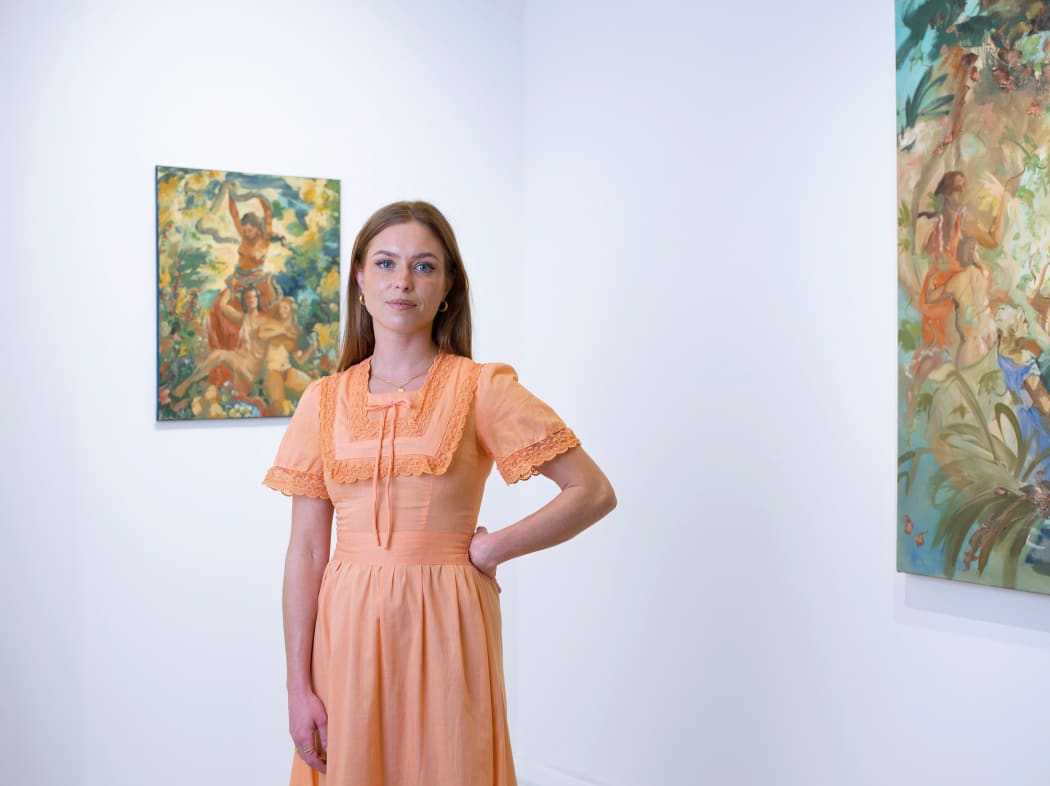
During Colette LaVette's solo exhibition, 'Fruitful Lands' at GJG, Gallery Manager, Emma Andreoli interviews the artist on her practice and what inspired this new body of work.
Emma Andreoli: What are the main themes you touch upon in your practice?
Colette LaVette: Re-wilding, naturalism, mythology, folklore, primitivism, trauma, healing.
EA: What are your sources of inspiration?
CL: In art directly, most paintings by Old Masters, particularly anything that has used light and rhythm to guide the viewer's eye. Far too many to mention but these include Artemisia Gentileschi, Virginie Demont-Breton, François Boucher, and Henryk Siemiradzki.
On the other hand, nature is a central influence in my work. I'm inspired by the ever-changing cycles in nature and the healing properties in growing something separate to yourself. The anticipation and unspeakable joy of witnessing a plant or a flower grow have become active metaphors in the scenes I paint.
EA: What brought you to investigate Rococo art alongside other art-historical periods?
CL: At first Rococo works lured me in because of their soft, gentle romanticism and opulence. However, I can't help but to have always been left craving something more real from these works, something more primitive, animalistic and carnal.
Whilst I'm preoccupied with art telling a story which of course Rococo art does, I am interested in the very origin of art, so I like to pair this research with Prehistoric cave paintings.
Looking into this period too allows me to explore how making marks that share a story is so deeply rooted within us, on the most primitive level. Art enables connection to those around us now and in the past. But if we're lucky, it might connect us to humankind when we're gone.
EA: What do you wish to communicate through your work and what reaction do you wish to incite in your audience?
CL: With biomorphic forms emerging from intuitive, expressionist marks, I want my paintings to continue to provide intrigue and allow new things to be discovered each time they are viewed. I hope they can provoke a sort of visceral introspection.
EA: Are there any biographical notes in your work?
CL: There is always a narrative I have in mind when composing a piece. Often these draw from my own human experience, given form by my dreams, folk tales and mythological narratives absorbed through literature. Some pieces explore themes like acceptance of human flaws, some reflect on regret and others express the joy of redemption.
EA:Natural pigment is paramount in your practice, how does it affect your creative process?
CL: I use a plethora of earth pigments such as iron oxides, ochres, earth laom and lapis lazuli. Mixed with linseed oil I create paints either on or off canvas and I use lavender oil as a paint thinner. In the beginning I was motivated by the low toxicity and sustainability of this process, but over time it has become a crucial way to have full control over the materials I work with and to tangibly connect with my practice in its entirety.
EA: How do you choose the figures you include in your work?
CL: For reference I have a library of images I have taken myself of family and friends with various poses alongside sketches of the great masters and of life drawing sessions. Many figures however are entirely improvised in order to achieve a certain rhythm without compromise. On the whole, most figures hold metaphorical meaning - for example when I paint younger figures I imagine them to be the inner child separated from nearby adults. These children sometimes engage independently with each other and can play a huge role in the scenes.
EA: And finally, what is the main theme running through the works in your latest series 'Fruitful Lands'?
CL: Nearly all motifs in these works are taken from my dreams or the metaphors I come across exploring nature and growing plants. They become the basis of these imaginary narratives that help me to deal with my experience as someone that seeks healing for myself and the earth. 'Fruitful Lands' is a sort of utopia where we and the land are both healed, it is the antithesis of the barren ground our intensive farming and industrialisation has perpetuated, and also the antithesis of unhealed and unresolved trauma within ourselves.
